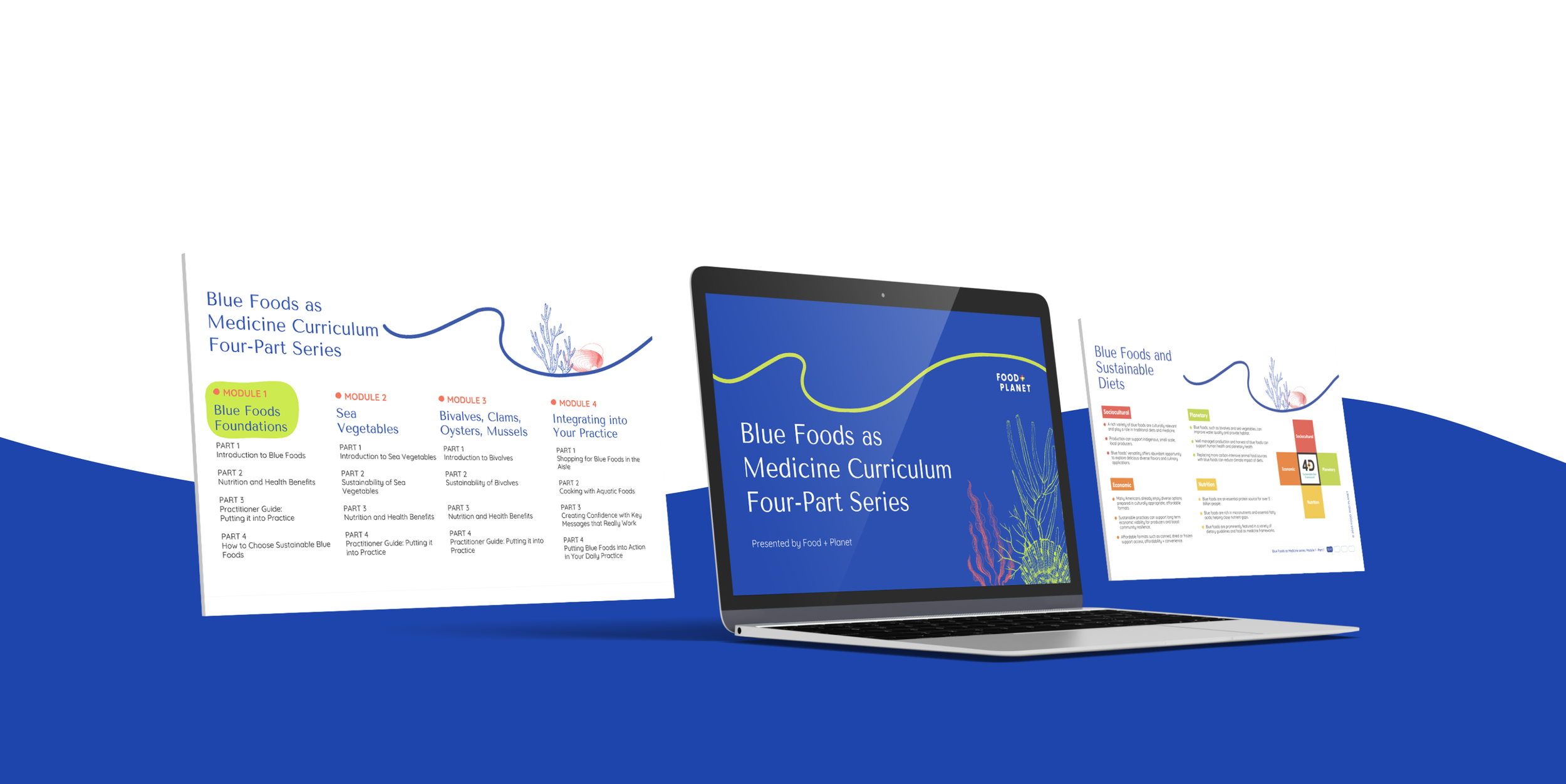
Unleash the power of blue foods in your practice to create positive change in your communities.
By taking this self-paced, online Blue Foods as Medicine course, you can gain the skills you need to understand the sustainability and health benefits of blue foods, find them in the supermarket aisle, prepare them safely and easily, and include them in delicious, healthful, traditional diets. What are you waiting for? Make a splash in aquatic foods by embracing these nutritious, delicious foods, and sharing your newfound knowledge with others today.
Blue Foods as Medicine is a FREE, interactive, four-part online curriculum for health professionals and students.
Action-Oriented Learning
Self-paced, evidence-based content that's focused on actionable ways to implement concepts across a variety of settings.
Culturally Diverse Recipes & Resources
Packed with 20 culinary medicine recipes, shopping guides, messaging tips, case studies, plus content and programming ideas.
Expanded Food as Medicine Framework
Our pioneering curriculum widens the food as medicine lens to include sustainability considerations and an array of aquatic foods.
Shareable, Open Access Content
Thoughtfully designed to advance the learning journey of health professionals (MDs, RDs, RNs), empower patients and students, and drive positive community change.
Module 1: Blue Foods Foundation
This module introduces practitioners to the foundation concept of blue foods and explores how blue foods can be successfully incorporated into a Food as Medicine framework. Using a systems thinking approach, participants will explore how blue foods hold significant potential to create a more nutritious, healthy, equitable, and sustainable future.
Define blue foods (also called aquatic foods) and their significance in improving human and planetary health.
1.
Learning Objectives
Describe 3 ways practitioners can integrate blue foods as Medicine concepts across U.S. population groups.
2.
Identify 2 strategies practitioners can use to support sustainable blue foods recommendations in daily practice.
3.
Module 2: Sea Vegetables
This module explores the diverse and delicious world of sea vegetables, including common varieties, nutritional significance, and how they can be incorporated into a Food as Medicine framework across U.S population groups. Practitioners will consider practical ways to help patients, clients, consumers and the public choose, prepare and enjoy sea vegetables with confidence.
Learning Objectives
Gain foundational knowledge of the nutritional significance of sea vegetables, and how they support the 4 dimensions of food systems sustainability.
1.
2.
Identify 3 strategies health practitioners can use to help patients identify and choose sea vegetables with confidence.
Describe 3 ways practitioners can incorporate sea vegetables into a variety of foods and foodways through practical approaches to support culinary nutrition and diverse diet patterns.
3.
Module 3: Bivalves, Clams, Oysters, Mussels
This module explores the diverse and delicious world of bivalves, including common varieties, where they are found, nutritional significance, and what makes them a highly sustainable protein choice. Practitioners will consider practical ways to help patients, clients, consumers and the public choose, prepare and enjoy bivalves with confidence.
Learning Objectives
1.
Gain foundational knowledge of the nutritional significance bivalves, and how they support the 4 dimensions of food systems sustainability.
Evaluate the environmental impact of bivalve farming and how it contributes to sustainable food systems.
2.
Recognize the economic and sociocultural advantages of bivalve cultivation and consumption.
3.
Module 4: Integrating into Your Practice
In this module practitioners will consider different perceptions, challenges and barriers people may have when considering whether to incorporate more blue foods into their diets. In addition they will explore actionable ideas for culinary demos, community engagement, and foodservice opportunities that can help integrate blue foods into a Food as Medicine framework, as well as how to understand common labels to choose sustainable options.
Learning Objectives
Describe common challenges, barriers, or perceptions people may have when considering whether to incorporate more blue foods into their diets, and ways to address them.
1.
Identify 3 strategies practitioners can use to help patients confidently select and prepare blue foods that meet their health goals and cultural considerations.
2.
3.
Share affordable recipes and simple culinary instruction and food safety tips in daily practice.








